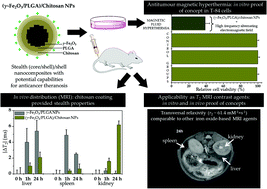Engineering of stealth (maghemite/PLGA)/chitosan (core/shell)/shell nanocomposites with potential applications for combined MRI and hyperthermia against cancer
Abstract
(Maghemite/poly(D,L-lactide-co-glycolide))/chitosan (core/shell)/shell nanoparticles have been prepared reproducibly by nanoprecipitation solvent evaporation plus coacervation (production performance ≈ 45%, average size ≈ 325 nm). Transmission electron microscopy, energy dispersive X-ray spectroscopy, electrophoretic determinations, and X-ray diffraction patterns demonstrated the satisfactory embedment of iron oxide nanocores within the solid polymer matrix and the formation of an external shell of chitosan in the nanostructure. The adequate magnetic responsiveness of the nanocomposites was characterized in vitro by hysteresis cycle determinations and by visualization of the nanosystem under the influence of a 0.4 T permanent magnet. Safety and biocompatibility of the (core/shell)/shell particles were based on in vitro haemocompatibility studies and cytotoxicity tests against HFF-1 human foreskin fibroblasts and on ex vivo toxicity assessments on tissue samples from Balb/c mice. Transversal relaxivities, determined in vitro at a low magnetic field of 1.44 T, demonstrated their capability as T2 contrast agents for magnetic resonance imaging, being comparable to that of some iron oxide-based contrast agents. Heating properties were evaluated in a high frequency alternating electromagnetic gradient: a constant maximum temperature of ≈46 °C was generated within ≈50 min, while antitumour hyperthermia tests on T-84 colonic adenocarcinoma cells proved the relevant decrease in cell viability (to ≈ 39%) when treated with the nanosystem under the influence of that electromagnetic field. Finally, in vivo magnetic resonance imaging studies and ex vivo histology determinations of iron deposits postulated the efficacy of chitosan to provide long-circulating capabilities to the nanocomposites, retarding nanoparticle recognition by the mononuclear phagocyte system. To our knowledge, this is the first study describing such a type of biocompatible and long-circulating nanoplatform with promising theranostic applications (biomedical imaging and hyperthermia) against cancer.



 Please wait while we load your content...
Please wait while we load your content...